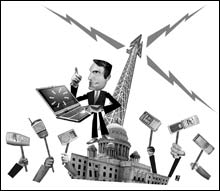 |
More than a million people have downloaded the “Hello Garci” ring tone — whose more than 11 versions variously incorporate samples from 50 Cent, Vanilla Ice, and the Beatles — making it one of the most popular clips to emerge from a cell phone. Yet the most provocative thing about “Hello Garci” is how it draws its inspiration not from a pop song, but a 2004 political scandal in which Philippine President Gloria Macapagal-Arroyo’s voice was captured while she allegedly discussed vote-rigging with elections official Virgilio “Garci” Garcillano.
Before the audio tape was released, “people kind of knew what happened, but since they embargoed the wiretap, the story [about the election] wasn’t getting out,” says Jo Lee, a technology consultant in Providence. Once the tape was leaked and it became a ring tone, the recording was unstoppable. While impeachment attempts and mass protests failed to throw Macapagal-Arroyo out of office, her approval rating has been consistently negative since the recording was released.
“It’s brilliant,” says Lee. “The president’s most humiliating moment is played over and over, every time a cell phone rings. It would be so effective here; it’s this great bumper sticker approach to guerrilla politics.”
The Philippine ring tone sensation suggests the potential power of netroots, the emerging movement of left-leaning activists, who are using technology and the Internet to find new ways of diffusing political power and getting more people engaged in politics.
In California, for example, MobileVoter, a group employing technology to promote civic engagement, used text messaging to register young voters, since texting is so popular with that age group, in 2006. Lee, who worked with MobileVoter, calls the idea “a no-brainer,” because “it literally puts a voter registration booth in the back pocket of every person.”
The unpopularity of President George W. Bush and his policies, particularly the war in Iraq, represented the biggest factor influencing Democratic gains in the 2006 elections. Still, the just-past election season will be remembered as the year when blogs came into their own, candidates got smacked around via YouTube, and Time declared “You” its Person of the Year, because of the ongoing “revolution” in personal technology and social networks.
So if 64.5 million Americans sent text messages to vote for their favorite contestants on American Idol — compared with 61.5 million who voted in 2006 US Senate races — should voting be as easy as sending a text message? Although technology won’t single-handedly revive broader political participation, the “Hello Garci” episode stands as a prime example of how it can bring together people, politics, and popular culture. And with the early stages of the 2008 presidential campaign underway, the netroots plan to keep pushing this envelope.
The birth of a new movement
By using online organizing, Democracy for America (DFA), which grew out of Howard Dean’s 2004 presidential campaign, has fostered an alliance of groups across the country. While DFA, like www.moveon.org, proved unsuccessful at mitigating Bush’s march to war, it provided a ready fundraising network when Seth Yurdin, chair of the group’s Rhode Island chapter, successfully ran last year for the Providence City Council.
Yurdin brought in about $4000 — a significant sum in a council race — from people around the country who had never met him, in average $35 donations, says Jeff Gale, vice chair of Democracy for Amer¬ica’s Rhode Island chapter.
In Rhode Island, the growth of the netroots accelerated when political activist Matt Jerzyk (an occasional Phoenix contributor) started Rhode Island’s Future, now the state’s most popular political blog, in March 2005. RI Future has since had 10 million hits, averaging 25,000 page views per day.